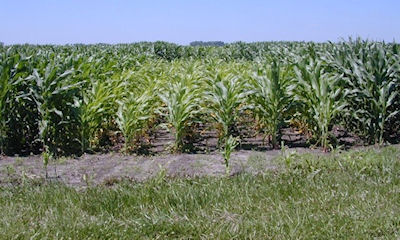
A new publication, "Nitrogen Use in Iowa Corn Production" (CROP 3073) released by Iowa State University Extension provides an overview of nitrogen use in regard to the soil system and corn fertilization. Included is use of economical optimum nitrogen rates and how they should be used to increase crop yields, to use nitrogen efficiently and to enhance water quality.

GOT NITROGEN? This is nitrogen-deficient corn (light green) next to corn that is getting enough nitrogen (dark green). Yield potential of corn that isn't fertilized with N will be very limited as the soil supply of plant-available N becomes depleted.
"Nitrogen is essential for growth and reproduction of crops and is involved in many important plant biochemical processes," says John Sawyer, professor of agronomy and Extension soil fertility specialist with Iowa State University and author of the new publication. "Nitrogen management is critical for optimal yields for corn production systems."
Nitrogen application rate guidelines using MRTN system
Of great interest to farmers, crop advisers, agricultural businesses and suppliers is the maximum return rate to nitrogen, or MRTN, system which is explained in the publication. It's the nitrogen rate approach used across the Midwest Corn Belt. The new publication has the nitrogen application rate guidelines for Iowa using the MRTN system. The guidelines are provided in both the publication and the online Corn Nitrogen Rate Calculator. Also, new rate guidelines were added for the southeast Iowa area.
The publication highlights long-term nitrogen rate research conducted in Iowa, where corn yields average 60 bushels per acre for continuous corn and 115 bushels per acre for corn following soybeans when corn is not fertilized. However, corn fertilized with proper nitrogen levels can easily yield 200 bushels per acre or more. Such yield increases highlight the importance of nitrogen use in corn production systems.
"MRTN is used through an online tool, the Corn Nitrogen Rate Calculator," explains Sawyer. Specific input criteria such as state or sub-state area, rotation, fertilizer product, fertilizer N price, and corn price are chosen by the user and are used to determine the suggested N rate per acre. That is called the MRTN rate. A most profitable N rate range is also provided, which provides N rates within $1 per acre of the maximum return. This profitable rate of N rate range provides flexibility in choice of rated to apply; with selection based on production risk tolerance, water quality concerns, maintaining soil N, and availability of other N response information or N diagnostic test results.
Crop rotations, nitrogen cycling in soil, economic return to N
While the MRTN approach provides guidance for N application rate, site-specific or seasonal-specific adjustments in the rate of N per acre you apply can be made with various tools such as the late spring soil nitrate test, or LSNT. Another tool you can use is corn plant stress sensing. A sensor measures the color of the corn plant and applies N fertilizer according to whether the plant is light green or dark green.
~~~PAGE_BREAK_HERE~~~
Explanations for use of these and other tools are provided in other ISU Extension publications at store.extension.iastate.edu.
The new publication "Nitrogen Use in Iowa Corn Production" also provides an overview of corn nitrogen fertilization use in different crop rotations, nitrogen cycling in soils, economic return to nitrogen application and nitrogen use relative to water quality. Soil is an open system where nitrogen losses occur naturally with the movement of water through the soil or with gaseous loss.
Striving for optimum corn yields, while minimizing N loss
The important point of the N rate response is the point of maximum economic return, which is always slightly below the maximum yield response because it takes some incremental yield increase to pay for the last amount of applied N, notes Sawyer. That is, the point of no net economic gain to more applied N. This concept is used in the MRTN calculation, whereby all N response trails are used to determine that point of maximum return -- the MRTN rate.
Jamie Benning, water quality program manager with ISU Extension and Outreach explains, "Farmers consider many factors when selecting nitrogen rates and timing of application, they strive for optimum corn yields while trying to minimize nitrogen loss and negative impacts to water quality."
For more information on related publications regarding soil fertility, go to the ISU Extension Online Store at store.extension.iaststate.edu.
About the Author(s)
You May Also Like




